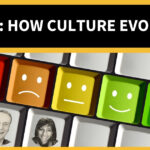In his recent column, “Why the Future is Going to Disappoint Us”, George Will presents the case that economic growth is likely to slow indefinitely, and that the unprecedented wealth creation of the 20th Century was a one-time and unrepeatable event.
I agree with this main thesis, as long as we stipulate that we are talking only about growth in the material realm. Economic wealth is of course crucial, especially when one is without it, but it represents a fraction of what it means to be human.
Development in the future will be of a different kind, located not just in the material but in the subtle and causal realms of life (which I explain below). And in these arenas we have already begun to experience a growth of mind, heart and spirit that I predict will be seen by future generations as anything but disappointing.
In this post I make that case, inserting my points in boldface within the context of Will’s admirable column, which follows.
Why the Future is Going to Disappoint Us
By George J. Will, March 25, 2016
Presidential campaigns incite both hypochondria and euphoria, portraying the present as grimmer than it is and the future as grander than it can be. As an antidote to both, read a rarity, an academic’s thick book (762 pages) widely recognized as relevant to America’s current discontents.
Robert J. Gordon’s “The Rise and Fall of American Growth” argues that an unprecedented and unrepeatable “special century” of life-changing inventions has produced unrealistic expectations, so the future will disappoint: “The economic revolution of 1870 to 1970 was unique. . . . No other era in human history, either before or since, combined so many elements in which the standard of living increased as quickly and in which the human condition was transformed so completely.”
What Will and Gordon describe as the “special century” is the particular American chapter of the story of a culture entering, and along with Western Europe, inventing the modern world (the Orange altitude of human development).
Those of us who aspire to world-centric consciousness, a population that unfortunately does not include George Will, will want to recognize an even more amazing story: that the move to modernity has since manifested in many other cultures as well, and continues to come online in most of the third world today. And thanks to the leap frog effect of technology, it is no longer taking a century.
In many ways, the world of 1870 was more medieval than modern. Three necessities — food, clothing, shelter — absorbed almost all consumer spending. No household was wired for electricity. Flickering light came from candles and whale oil, manufacturing power from steam engines, water wheels and horses. Urban horses, alive and dead, complicated urban sanitation. Window screens were rare, so insects commuted to and fro between animal and human waste outdoors and the dinner table. A typical North Carolina housewife in the 1880s carried water into her home eight to 10 times daily, walking 148 miles a year to tote 36 tons of it. Few children were in school after age 12.
But on Oct. 10, 1879, Thomas Edison found a cotton filament for the incandescent light bulb. Less than 12 weeks later in Germany, Karl Benz demonstrated the first workable internal combustion engine. In the 1880s, refrigerated rail cars began to banish “spring sickness,” a result of winters without green vegetables. Adult stature increased as mechanical refrigeration and Clarence Birdseye’s Birds Eye frozen foods improved nutrition. By 1940, households were networked — electrified, with clean water flowing in and waste flowing out, radio flowing in and telephonic communications flowing both ways. Today’s dwellings, Gordon says, are much more like those of 1940 than 1940 dwellings were like those of 1900. No more lack of privacy for people living and bathing in the kitchen, the only room that was warm year-round.
Astonishing progress indeed. This is what the philosopher Daniel Dennett refers to as “the spectacularly tangible results of modernity”: thirty millennia of subsistence living transformed into material plenty in the span of three generations.
Since 1940, however, only air conditioning, television and the Internet have dramatically changed everyday life, and these combined have not remotely matched the impact of pre-1940 changes.
Oh yes they have, particularly the latter two: television and the internet. This is where Will and most economists would benefit from an integral view. What they miss is the nature of change itself. Let me explain using the little bit of integral theory:
One of the key pillars of Ken Wilber’s AQAL model posits that human beings inhabit three bodies: 1) our physical bodies, 2) our subtle bodies, which consist of thought and energy, and 3) our causal or spiritual bodies. Although all three are online throughout human evolution, the human project focuses on each in turn as we develop.
Human history up through modernity has been dedicated to providing for the needs of our physical bodies: food, shelter and security, as we see in Will’s overview.
But evolution is not linear, and further progress does not mean that we consume ever more calories, square footage or kilowatts. On the contrary, there appears to be a ceiling on the benefits of increased material wealth. Once we are living at a baseline of food, shelter and safety that is adequate and proportional to others, then more and bigger do not necessarily make us happier. Often they do the opposite, as we see with the appearances of humanity’s new problems such as obesity, alienation and affluenza.
The postmodern project of evolution is to knit our minds and hearts together in a new economy located in the subtle and even causal realms. Post-modern people are not materially wealthier than modern people. In fact we often eschew material pursuits for a life richer in relational, artistic and spiritual rewards. In the process we must be careful not to undervalue the systems that create the material world that accords us that privilege.
Nineteenth-century medicine mostly made patients as comfortable as possible until nature healed or killed them. In 1878, yellow fever killed 10 percent of the Memphis population. But 20th-century medicine moved quickly from the conquest of infectious diseases (the cause of 37 percent of deaths in 1900; 2 percent in 2009) to the management of chronic ailments of the elderly. There were 8,000 registered automobiles in 1900 but 26.8 million in 1930. Ford’s Model T, introduced in 1908 at $950, sold in 1923 for $269.
Again, astonishing. Exceeded only, perhaps, by the real-time proliferation of the subtle space, the world of information and communication, which has exploded in the last twenty years (and created its own kind of “information affluenza.”). Remember, people, we didn’t have email twenty years ago.
It’s hard to overestimate the change wrought by a world where:
- We can find out anything about anything by speaking into a slab of magic that we keep in our pockets.
- Where we can make “needle in the haystack” friendships with people who live anywhere in the world, creating communities of like-minded people who are consciously bringing in the new — like the integral community!
- Where our prejudices are challenged by relentless exposure to different worldviews bringing on a flexibility of mind and heart.
- Where we can sit at the feet of the greatest saints and teachers of all times and cultures, and walk any path that calls to us.
- Where, at some point, if we’re lucky, our consciousness expands to include all the perspectives we have integrated, and begins to identify with the space within which perspectives arise, as needed, under their own power. This is the world of integral consciousness.
Gordon says two calamities — the Depression and World War II — fueled the postwar boom: The Depression by speeding unionization (hence rising real wages and declining work hours), the war by high-pressure “productivity-enhancing learning” that, for example, manufactured a bomber an hour at Michigan’s Willow Run plant.
Ain’t that just the way of things? Whether it’s a dinosaur-killing asteroid, the horrors of the mid-20th century, or a tragedy in our own lives, a systemic breakdown often sparks a boom in growth.
But the classic modernization trek from rural conditions into sanitized urban life and the entry of women into the workforce were vast, unrepeatable advances. Today the inflation-adjusted median wage of American males is lower than in 1969, and median household income is lower than when this century began. If the growth rate since 1970 had matched that of 1920 to 1970, instead of being one-third of it, per capita gross domestic product in 2014 would have been $97,300 instead of $50,600.
So I guess we’ll get there slower. Remember, the orienting principle of the modern economy (orange altitude) is growth and the orienting principles of the postmodern economy (green altitude) are equality and sustainability. The issue going forward is to integrate the two: wealth creation and wealth distribution, so that everybody gets the benefits of his or her contribution, and nobody gets left behind.
America’s entitlement state is buckling beneath the pressure of an aging population retiring into Social Security and Medicare during chronically slow economic growth. Gordon doubts the “techno-optimists” who think exotic developments — robots, artificial intelligence, etc. — can match what such by-now-banal developments as electricity and the internal combustion engine accomplished. There is, however, no reason to expect that medical advances have been exhausted. And there are many reasons to believe that the rapid expansion of regulatory, redistributive government, which can be reformed, has contributed to — it certainly has coincided with — the onset of (relative) economic anemia.
One could just as easily make the case that the expansion of regulatory, redistributive government wrested the nation’s wealth from the hands of the robber barons, ended child labor, and created the social safety net that kicked off the mid-century economic boomtime.
The “fatal conceit” (Friedrich Hayek’s term) is the optimistic delusion that planners can manage economic growth by substituting their expertise for the information generated by the billions of daily interactions of a complex market society. Gordon’s stimulating book expresses a pessimist’s fatal conceit, the belief that we know the future will be less creative than the “special century.”
Good point. The nature of creativity is that we don’t know. But integral theory reveals an important propulsive force: the enduring polarity between the individual and the collective, a polarity that evolves through the process of conflict and integration.
We humans have developed through many economic systems, starting with hunting and gathering, and each system has had to manage the tension between free enterprise and collective control. Each thought themselves eternal and none anticipated what was coming next. There is no reason to believe that systems of modernity represent the end of economic transformation.
Indeed integralism shows us that change will continue, creating an economy that integrates a sustainable material base with a new economy of the mind, heart and spirit.
 Send your questions and comments for the show to [email protected]. Record a voice memo on your smartphone or use the Speakpipe button to the right.
Send your questions and comments for the show to [email protected]. Record a voice memo on your smartphone or use the Speakpipe button to the right.






